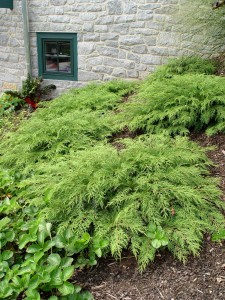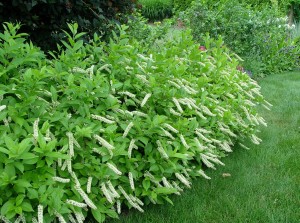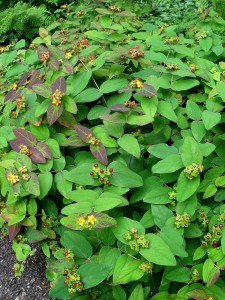10 Great Plants for a Bank
1.) Blue holly (Ilex x meserveae). Dark blue-green broad-leaf evergreens that grow 6 to 8 feet tall and wide — and beyond, in time. My favorite two are ‘Blue Prince’ and ‘Blue Princess,’ a male and female pair that’ll give you red fall berries on ‘Blue Princess.’ Full sun to at least part shade.
2.) Russian cypress (Microbiota decussata). A soft-needled medium-green evergreen that grows in a sort of layered spray about a foot tall. Reaches out 6 feet per plant, making a nice groundcover tall enough to shade most weeds. Best in shade or part shade.
3.) Dwarf goldthread cypress (Chamaecyparis pisifera). A soft-needled evergreen with a shaggy habit and golden color (more green gold in part sun). Nice texture, bright color and very durable. ‘Gold Mop’ is my favorite. Sun or half-day shade.
4.) Spreading Japanese yew ‘Repandens’ (Taxus baccata). I’m not a yew fan, but this is one that grows into an undulating evergreen groundcover about 3 feet tall and 6 feet wide. Excellent massed and never pruned. Shade or part shade.
5.) Shrub roses. They’re virtually indestructible even in lousy soil and bloom almost non-stop all season. Space 4 to 5 feet apart massed on a bank. Pruning isn’t mandatory. Full sun to part shade.
6.) Virginia sweetspire (Itea virginica.) A native flowering shrub that gets arching white bottle-brush flowers in late spring and glossy scarlet foliage for weeks in late fall. Runners colonize to make a tight weed-choking planting and to head off erosion. ‘Little Henry’ is my 3-foot-tall favorite. Shade to nearly full sun.
7.) Red switchgrass (Panicum virgatum.) A native grass that grows 3 to 4 feet tall and becomes tinged in burgundy by late summer. Also gets dainty pinkish seed heads. Clumps slowly expand to form a tight mass. Makes a good textural contrast to evergreens and shrubs. Full sun to light shade.
8.) Catmint (Nepeta fassenii).Tough perennial with silvery gray foliage and blue flowers that rebloom if you cut back the foliage in mid-summer after the first round of flowering. Does best with that cut and a second one at winter’s end… otherwise, no watering or fertilizing. ‘Walker’s Low’ grows 2 feet tall, ‘Kit Kat’ and ‘Blue Ice’ are 15-inchers. Full sun.
9.) Hardy geraniums. Not related to the annual red geraniums that everyone grows in pots (those are Pelargoniums), these true geraniums come back every year and spread 2 to 3 feet with a height of 12 to 18 inches. Leaves are lacy, and blooms are lavender, blue/purple, pink or white. ‘Rozanne’ and ‘Jolly Bee’ are two of the best long-bloomers. Sun or part shade.
10.) Liriope (Liriope muscari). Tough and versatile, this perennial looks like a foot-tall grass but gets spiky purple flowers in late summer. Grows in a spreading clump and needs only one end-of-winter whackback with a string trimmer. Liriope spicata is a cousin that’s a more aggressive spreader — useful by itself in a mass where there are no neighbors to invade. Sun or shade.
BONUS: Even more plants to try on a sunny bank.
6 feet and up: Arborvitae ‘Emerald Green’ or ‘Green Giant,’ Hinoki cypress, upright junipers ‘Emerald Sentinel’ or ‘Blue Point,’ Leyland cypress, crape myrtle, lilac, ninebark, viburnum.
3 to 6 feet tall: Shrub roses, miscanthus grass, feather reed grass, birds nest spruce, caryopteris, dwarf forsythia, Japanese spirea, St. Johnswort.
Under 3 feet tall: Japanese garden juniper, aster, black-eyed susans, purple coneflowers, daylilies, beebalm, coreopsis, sedum, gaillardia, salvia.
DOUBLE BONUS: More plants to try on a shady bank:
6 feet and up: Upright yew, Manhattan euonymus, beautyberry, oakleaf hydrangea, arrowwood viburnum.
3 to 6 feet tall: Boxwood, cherry laurel, Japanese plum yew, deutzia ‘Nikko,’ fothergilla, smooth hydrangea.
Under 3 feet tall: Sweetbox, Japanese forestgrass, Pennsylvania sedge, dwarf nandina, coralbells, hosta, foamflowers, barrenwort, foamybells, hardy ginger, pachysandra, ferns, Solomon’s seal, leadwort, helleborus.











